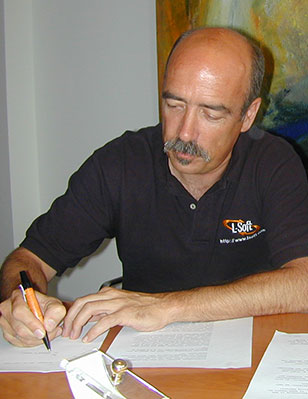 |
|
|
Views from the Frontlines: 1. Can you tell our readers when you first started working with LISTSERV? 
In October 1987, I became the German Country Coordinator for the computer network EARN/BitNet/NetNorth. This joint network was an early version of today's Internet, based on IBM communication protocols, offering services such as international routing and connectivity, electronic mail, network management and directory services. On IBM mainframe computers, everything was a job, be it sophisticated calculations, printing, interactive messages (a pre-historic form of an SMS), email or file transfer. So the protocol used at the time was called NJE, Network Job Entry. LISTSERV was a service running on a backbone of central and regional hubs, using basically a store-and-forward email communication protocol. Our LISTSERV instance was running on an IBM mainframe computer with the VM operating system being responsible for all traffic coming to and originated from Germany and some countries behind Germany in an international routing topology defined and maintained in one central text file called BITEARN NODES. Its name was DEARN. Other central nodes had similar names like AEARN (Austria), BEARN (Belgium), CEARN (Switzerland), HEARN (the Netherlands or Holland) and SEARN (Sweden). The European Central EARN node was in Montpellier and was called FRMOP11. 2. When did you first meet Eric Thomas, the inventor of LISTSERV? Eric Thomas was not only the author of LISTSERV, but he was also the mastermind of the international LISTSERV topology and the escalation instance for the folks at FRMOP11. So I had my first contact with him in the fourth quarter of 1987 through a pre-historic SMS message in which he asked me to apply some patches to our LISTSERV instance. I met Eric in person in early 1988 on occasion of an EARNTECH meeting. EARNTECH was one of the international working groups of the EARN Association being drafted with the smooth and future-proof operation of this network. Eric was working at CERN in Geneva. CERN was the central European hub at that time, having the one and only transatlantic communication line to the United States, specifically to Princeton, NJ. Years later, a second line was established to the United States from Germany: Bonn to the City University of New York (CUNY), a longtime LISTSERV user, with the ultra-fast speed of 64 kbps. EARN finally merged into a corporation called TERENA in 1996. As EARN did before, TERENA hosted an annual conference, which was another occasion to work with Eric and a small team including Ben Parker, Chief Corporate Consultant of L-Soft. 3. When did you start working for L-Soft and how did you end up as Managing Director of L-Soft Germany? On New Year's Eve 1999, my family decided to move to the United States. Luckily we found out that there was an opportunity at L-Soft in the United States. On September 1, 2000, I did a job interview with Eric and Outi Tuomaala, L-Soft EVP, in Stockholm, Sweden. Then we had to wait for the papers. I started as VP of Computer Services in the Washington, DC, area on May 7, 2001. To broaden the portfolio of L-Soft's product offerings, Eric decided in early 2001 to acquire a Swedish marketing communication company that had a development office for an email tracking solution in Erlangen, Germany, with the idea of integrating tracking into LISTSERV. So Eric was looking for someone who was supposed to understand the Germans best: me. I visited the Erlangen office for the first time in May 2001 together with Eric and others. I became the Managing Director of L-Soft Germany GmbH, founded in July 2002, and we launched the LISTSERV Maestro email marketing solution that year. 4. What are your thoughts on how LISTSERV and email have developed since the early days? When we look at electronic communication today, email started it all. It was a complete paradigm shift to distribute and share information with others though email. With a few email users, there was no need for LISTSERV, but this changed quickly. Email is still the workhorse in electronic communication. These days it's a lot about trackability, accountability and security. What I like most about email is that it's fast and asynchronous. You leave it to the recipients to reply when they are in a position or mood to do so. This creates much better results. Today you don't even have to empty your inbox. Thanks to the computing power available and smart search algorithms, you're able to find email messages that you're looking for in no time. 5. What role do you see LISTSERV Maestro playing in modern email communication? In modern email communication it's also about return on investment (ROI) and impact. LISTSERV Maestro gives you this information. You can see and evaluate what happened in your marketing campaign, and you can work with the results (cascading) and be better and more successful in your next campaign based on the information collected by LISTSERV Maestro. 6. How do you think email is going to continue changing and developing during the next decade? Email as such has come a long way. Today, you're able to transport reliably all kinds of information through email up to size limits that we didn't even dream about in the early days. Security will become even more important and then it will be about convenience and integration into the workflow. Subscribe to LISTSERV at Work. |
|
© L-Soft 2016. All Rights Reserved. |
|
|

